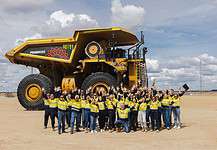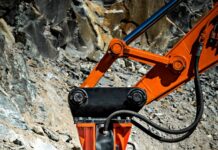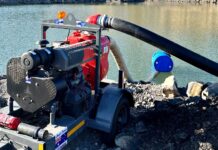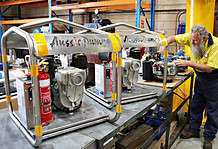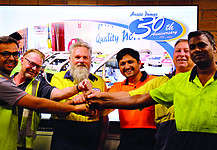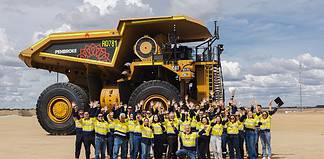Lifting heavy machinery to undertake maintenance is a high-risk activity on any mine site, with potentially disastrous outcomes if not done correctly.
Before anyone gets underneath a large mining truck, they must be confident that the jack supporting it is in proper working order.
This need for absolute confidence has remained a key focus for EDMO Australia as it continues to develop new equipment and encourage newer, safer practices.
According to EDMO director Scott Bullard, “if you’re asking someone to lift a 300 ton truck and then get underneath it, the last thing you want is for them to be worried about whether the jacking equipment being used to lift and hold it is working”.
“The confidence our customers have in our equipment is vital.”
As part of EDMO’s commitment to producing jacking equipment to allow for safe heavy lifting, every jack that leaves its factory has gone through a full testing regime, which exceeds Australian standards.
That regime takes all safety features and nameplate operating capacity into account, whether it is a newly manufactured jack or one that has come in for service.
This process includes dynamic load testing, conducted at a purpose-built in-house facility, which is electronically controlled.
Scott said the testing regime was an integral part of EDMO’s manufacturing process.
“During the testing phase, each jack is subjected to twice the load it has been designed to take and each stand is subjected to three times its nameplate capacity to check for any deformities,” he said.
“That means that if you have a 150 ton stand, we’ve got 450 ton punching through a test facility to make sure that it won’t give up the ghost if an unintended load were to be experienced.
“Like all testing, it’s well documented and customers are privy to the results and can see the relevant documentation.”
Safer Practices
As a result of its commitment to safety while heavy lifting, EDMO maintains a zero-incident record; however, according to Scott, the company is always striving to improve.
“All mine sites consider jacking and standing to be a high-risk activity and they have quite a stringent set of operating procedures with regards to those operations,” he said.
“However, one of the areas we’ve identified for improvement is regular testing of jacking equipment.”
Although most jacks and stands are inspected every six months on mine sites, they are not always tested under dynamic load.
Scott said testing practices regarding jacking equipment should be brought into line with other high-risk activities and should be part of a site’s service strategy.
“We believe that given the importance of the equipment, the jacks really should be tested to show that the load and safety control devices are in fact operating as they were intended and that can only be determined under load, so we’re really trying to encourage that on mine sites.”
Jacks of the Future
Beyond encouraging a change in processes on site, EDMO is also examining innovations in the equipment itself to improve safety and operator confidence.
Although currently still in development, Scott said EDMO was working closely with the mining industry to produce new, more user-friendly lifting options.
“We’re listening to industry and we know that when it comes to jacks there is a real push for ease of operation, lighter materials and anything that creates safer operator outcomes with regard to the use of mining equipment,” he said.
“At the moment, we’re trying to work towards solutions that accommodate those requirements and make them more user friendly when it comes to the physical demands of using the equipment.
“It’s a very symbiotic relationship with regards to developing new processes and implementing new equipment.”
The new lifting options would not only improve safety outcomes in the traditional workforce but would support major miners’ goal to encourage more employment diversity.
It comes after EDMO was tapped to provide jacks to BHP’s FutureFit Academy, which has campuses in Queensland and WA.
Launched in May 2020, the Academy was designed to open the door to a more diverse group of workers, particularly those from non-mining backgrounds who were looking to reskill or pursue a new career.
BHP describes it as the workforce of the future.
Scott said the team at EDMO were always happy to part of product development and was always looking for industry feedback as well as the chance to pitch their own ideas.
“The good thing about the mining industry is that they’re always welcoming new product development that gives a better or safer outcome to an existing operation,” he said.
“If you prove to them, or if it’s obvious that by introducing a certain process or a refinement of a product, it will create a safer outcome, they’re quick to encourage the development of it.”
Custom is King
While innovation is always in mind at EDMO, Scott said the company was also dedicated to continuing its long history of providing top quality jacking equipment suitable for any job at mine sites around the world.
“EDMO is in a position to be able to provide specialised applications for particular requirements,” he said.
“Not all mine sites run the same gear, so for example, if someone’s got a jacking requirement for the biggest of haul trucks then they could use our jacks and stands, but we also provide specialised load caps for the many models of trucks available.
“A load cap is the final piece of the puzzle, so you have your jack, sometimes a small extension, and then you have the load cap that’s sitting on top of it as the interface between the jack and the actual lifting point of the truck.”
Lifting points, or jack points, are not always flat and they do not always have a uniform configuration.
Scott said in this case, a specialised fitment must be manufactured to give the best possible fit and the best possible safety and operator security.
“Similarly, trucks have different jack heights, so the jack point on some trucks could be really quite low,” he said.
“It’s not a one-jack-fits-all application, and as many trucks there are out there, so too are there different kinds of interfaces and jacking requirements.
“At EDMO, we look at all the different requirements and produce a jack to match.”
Scott believes it is this ability to customise and adapt that has seen it continue to corner the Australian market and to thrive internationally.
“The biggest thing we can provide is that in a situation when a customer comes to us with a problem like a new truck that won’t fit with an existing load cap, we can go out on site to take a look, measure it, create a design, engineer it, and it will be available for our customer within a few months,” he said.
“We can pivot and be nimble so that we can take something from an idea to a fully engineered, bespoke piece of equipment.”
Scott said this ability to adapt went beyond jacks and stands.
“We also manufacture jack stands, stand carriers and tyre stands” he said.
“Just recently we had a customer with an existing EDMO tyre stand who wanted to create efficiencies in an operation by being able to accommodate two tyres instead of one, so it meant going back, extending, re-engineering and recertifying.”
All EDMO equipment is manufactured in Australia to meet or exceed safety standards throughout the world.
Founded more than 50 years ago, EDMO is now used in 22 countries including the United States, China and Africa.




